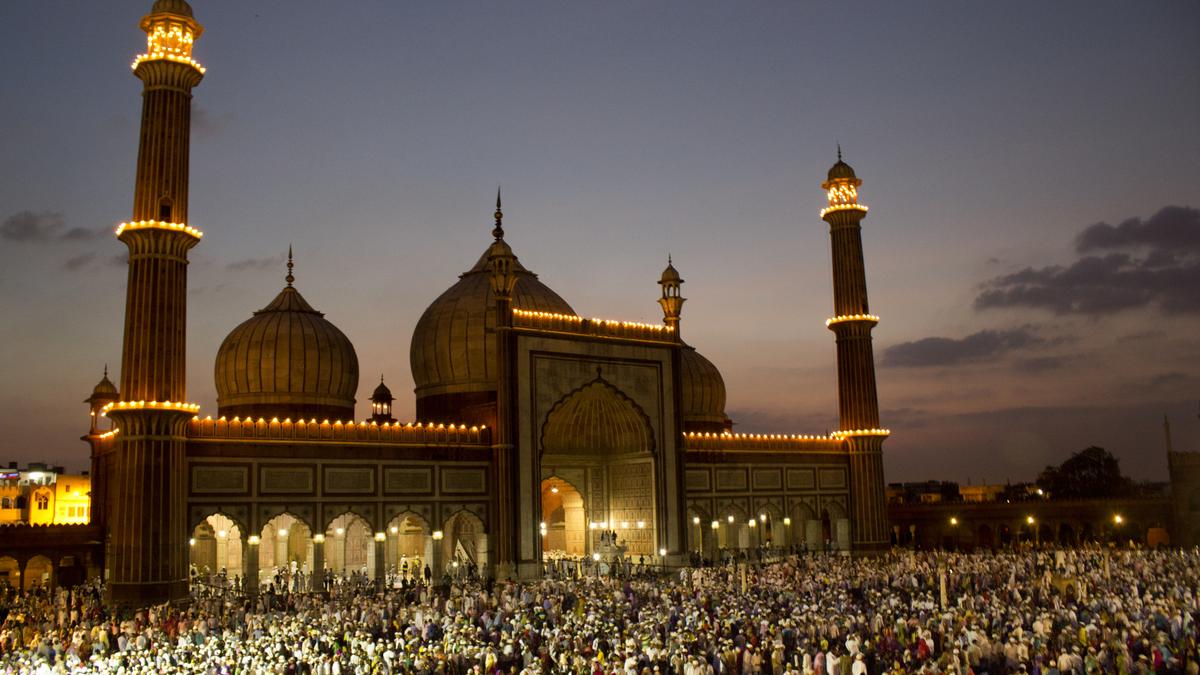A gathering in front of Jama Masjid, Delhi.
| Photo Credit: Getty Images/istock
Ever since the Vishwa Hindu Parishad took up the Ayodhya temple project in 1984 there have been frequent calls asking Muslims to choose between Pakistan and the graveyard. Young Muslims have often been called ‘Babur ki Aulad’ (progeny of Babur). Not one politician of any hue has deemed it necessary to counter calls for mass violence. No Muslim, for instance, has been called ‘Abdul Hamid ki Aulad’. Hamid was a braveheart who sacrificed his life in the 1965 war with Pakistan.
Spectators during the third One Day International cricket match between India and Pakistan, in Karachi, oppose the construction of a temple on the Babri Masjid demolition site.
| Photo Credit:
V.V. Krishnan
The VHP project culminated in the criminal destruction of the Babri Masjid in 1992. Hatred and social stigmatism of Muslims, however, continue even after a grand Ram Temple has come up at the site of the mosque this year. That’s the harsh reality. A section of the majority community seems to get provoked by any marker of Muslim identity. As Hilal Ahmed writes in A Brief History of the Present: Muslims in New India, “The established markers of Muslim presence — skull cap, beard, hijab, minarets of mosques and even an advertisement written in Urdu — are being perceived as civilisational threats to Hinduism. Muslims are targeted, abused, insulted and even lynched to death in public to assert nationalism in overtly Hindu terms.”
Muslims in Bengaluru protesting against the Central government’s lack of action against mob lynching and attacks on the community across India.
| Photo Credit:
K. Murali Kumar
What’s in a name?
For many, having a Muslim name is to be vulnerable to daily assaults in ‘New India’, as Ahmed shows, beginning his introduction by recalling the train incident in which a Railway Protection Force constable had allegedly killed three Muslim passengers merely because of their names.
Of course, a large section of the media also plays a dubious role in portraying Muslims as villains out to destroy the social fabric of the country with varied versions of jihad, some so fanciful that Muslims themselves would not have heard of them. Like for instance, the so-called Tomato Jihad or Flood Jihad in Assam or Film and Music Jihad. Yet it goes on, and Muslims are presented as a monolithic group, all shades of variety and heterogeneity erased to present a clear opponent for Hindutva politics. It’s to Ahmed’s credit for saying a lot without launching into a diatribe.
A man doing yoga on the lawns of Humayun’s Tomb, in New Delhi.
| Photo Credit:
Getty Images/istock
In dispassionate observer mode for much of the book, he lists incidents, the causes and the aftermath. Many of the incidents of brutal attacks or subtle othering of Muslims that find space here would be known to readers who keep in touch with news portals. Yet they needed to be culled together to make a persuasive argument. That is what Ahmed does. Happily not carrying the burden of the success of his book, Siyasi Muslims here, Ahmed brings into play his academic rigour to give us an engaging book whose canvas is vast and the view panoramic as he analyses the whys and hows of contemporary India.
Long shadow of Aurangzeb
‘Raja Shivaji at Aurangzeb’s durbar’
| Photo Credit:
Special arrangement
For instance, inevitably, he talks of Aurangzeb, seen as an Islamic tyrant who demolished temples, imposed jizyah, and banned music. Ahmed though cuts the clutter, writing, “Our public discourse… relies on a strong assumption that Muslims admire Aurangzeb as a respectable Islamic figure and that any attempt to defame him would eventually upset them…. The secular reception of Aurangzeb is equally one-sided. A section of scholars wants to destroy the communal ‘myths’ to discover a ‘tolerant and secular Aurangzeb’.” The fact remains that the so-called Muslim rule of Aurangzeb did not really improve the lot of the community.
Not many think on those lines. As a result, for every Aurangzeb, Shivaji is held up as an icon, for every Akbar, there is Rana Pratap and for every Alauddin Khalji, there is Padmini. This contest of the alleged Muslim icon versus Hindu icons reduces history to a game of one-upmanship.
Pasmanda (Backward class) Muslims at a meeting organised by the BJPs minority wing, in Lucknow.
| Photo Credit:
Sandeep Saxena
Ahmed traverses much beyond that in this book which deserves careful consideration. He dares to talk of Pasmanda politics, Muslim religiosity, and tries to analyse the shrinking space for the Muslim liberal, writing, “The role of liberal Muslims in liberalising Islamic intellectual debates in a Hindutva-dominated environment cannot be ignored.”
It may be a bit early to see how the contours of Pasmanda discourse evolve as the Bharatiya Janata Party itself has failed to back up Prime Minister Narendra Modi’s new-found love for the community with concrete policies. Yet, it does question the hegemony of the well-heeled and the traditionally well-educated among the Muslim community.
Over the past few years, there have been many attempts at projecting the challenges of being a Muslim in the age of resurgent Hindutva. Ahmed’s book, replete with understatements, and a calm and quiet reasoning, is a welcome addition.
A Brief History of the Present: Muslims in New India; Hilal Ahmed, India Viking, ₹599.
ziya.salam@thehindu.co.in
Published – October 18, 2024 09:00 am IST

